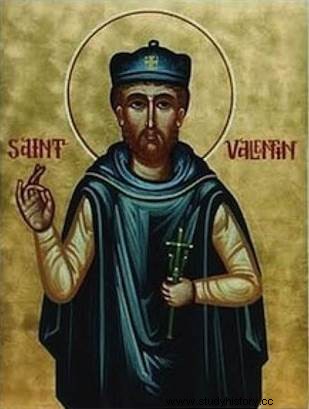 Celebrated on February 14, Valentine's Day is since the 15th century the feast of lovers. The tradition is that we offer this day some special attention to his other half. This custom probably originated from the ancient feast of the Lupercalia (February 15 in ancient Rome). However, we can ask ourselves the question of the choice of this date and the link with Valentine's Day . Besides, what do we know about the history of this saint whom the Church replaced in its calendar by Saint Cyril and Saint Methodius at the end of the sixties? Here are some answers.
Celebrated on February 14, Valentine's Day is since the 15th century the feast of lovers. The tradition is that we offer this day some special attention to his other half. This custom probably originated from the ancient feast of the Lupercalia (February 15 in ancient Rome). However, we can ask ourselves the question of the choice of this date and the link with Valentine's Day . Besides, what do we know about the history of this saint whom the Church replaced in its calendar by Saint Cyril and Saint Methodius at the end of the sixties? Here are some answers.
Story of St. Valentine, Christian Martyr
On February 14, several beatified Valentines are celebrated. However, Valentine's Day in Terni, at the time of ancient Rome, was the one most generally assimilated to the feast of lovers. According to the Roman Martyrologist, Saint Valentine of Terni was a miracle-working Christian priest who lived in the 3rd century under the reign of Emperor Claudius II, known as the Gothic. In 269, Saint Valentine was arrested, flogged, condemned to death and then beheaded on the Flaminian Way in Rome by order of Placide, prefect of Terni. Three Christians (Saints Procule, Ephebe and Apollone) who came to pray at night near his body were also executed.
Other disciples of Saint Valentine would have been victims of anti-Christian persecutions such as Saint-Craton, known as "the Athenian", a professor of rhetoric baptized by Saint Valentine who was executed with his family in Rome. When Christianity was no longer persecuted and became the state religion, the cult of Saint Valentine spread, especially in Bavaria. Indeed, relics were brought to Mais, then to Passau in 764. The patron saint is represented there with a crippled child lying at his feet, recalling that the saint was a miracle worker. He is also invoked for the healing of epileptics. But besides his talents as a healer, Saint Valentine is also the patron saint of beekeepers and fiancés.
Origin of Valentine's Day, lovers' day
The origin of the connection between the martyr and the lovers is not completely clarified and several hypotheses are put forward and complement each other. It has sometimes been pointed out that Saint Valentine, patron saint of lovers, had been the spearhead of the Church, and more particularly of Pope Gelasius I (around 498) to thwart the pagan feast of the Lupercalia. During this feast in honor of Faunus a goat was sacrificed in the cave of Lupercal (at the foot of the Palatine Hill), then the drunken priests of Faunus ran through the streets with shreds of goatskin with which they touched passers-by. For a young woman, being touched should ensure better fertility and facilitate childbirth. However, and even if the pagan feast was gradually eclipsed by the Christian feast, the feast of Saint Valentine does not seem to have been devoted to couples at that time, which contradicts the idea of a tailor-made anti-pagan feast.
 Indeed, the link between Valentine's Day and courtly love only seems to appear in the Middle age, around the fourteenth century, while it was considered that February 14 (date certainly fixed in the fifth century), corresponded to the period when the birds begin to pair:the feast of the saint therefore corresponded to a natural period of pairing. In reference to this naturalistic and poetic vision of love, young people then exchanged notes by calling each other their Valentine. This mainly Anglo-Saxon tradition spread on the continent through poets like Othon de Grandson.
Indeed, the link between Valentine's Day and courtly love only seems to appear in the Middle age, around the fourteenth century, while it was considered that February 14 (date certainly fixed in the fifth century), corresponded to the period when the birds begin to pair:the feast of the saint therefore corresponded to a natural period of pairing. In reference to this naturalistic and poetic vision of love, young people then exchanged notes by calling each other their Valentine. This mainly Anglo-Saxon tradition spread on the continent through poets like Othon de Grandson.
At the same time, various legends are born around Saint Valentine which bring the Saint closer to young lovers:thus it is said that he was arrested because he celebrated marriages whereas Claudius II had forbidden them to his soldiers. It is also said that he restored sight to the daughter of his jailer who came to visit him daily so that he could describe the world to her:before being beheaded, the saint would have sent him a note signed "Your Valentin". The new fervor of lovers towards Saint Valentine would have led to the formalization of this patronage by the Church at the end of the 14th century under Pope Alexander IV.
Valentine's Day today
In the 19th century, Valentine's Day became increasingly popular with the sending of cards between friends and lovers, then almost exclusively between the latter. However, in 1969, the Catholic Church removed from its calendar the feast of saints considered legendary:Saint Valentine, whose history remained obscure, was part of the lot.
Thus, contrary to what your calendar might announce, February 14 has become the feast of Saints Cyril and Methodius (two brothers who evangelized the Slavs in the 9th century century) ! This does not prevent Saint Valentine of Terni from remaining celebrated on this day in some parishes and being an integral part of Western Christian culture.
Nowadays Valentine's Day, like many other celebrations, has become a very lucrative commercial holiday. Thus in the United States, several billion dollars are spent that day by young men and girls on gifts, greeting cards, outings, flowers...
Sources
- Roman Catholic Martyrologist
- BAUDOIN Jacques, Grand livre des saints. Worship and iconography in the West, Create, 2006.
To go further
- The Book of Christian Martyrs, by Bruno Chenu. Centurion, 1988.
- Poems:Volume 1, The Restraint of Love, by Charles d'Orléans. Honored Champion, 2010.

